James McNeill Whistler (1834-1903)
Get a James McNeill Whistler (1834-1903) Certificate of Authenticity for your painting (COA) for your James McNeill Whistler (1834-1903) drawing.
For all your James McNeill Whistler (1834-1903) artworks you need a Certificate of Authenticity (COA) in order to sell, to insure or to donate for a tax deduction.
Getting a James McNeill Whistler (1834-1903) Certificate of Authenticity (COA) is easy. Just send us photos and dimensions and tell us what you know about the origin or history of your James McNeill Whistler (1834-1903) painting or drawing.
If you want to sell your James McNeill Whistler (1834-1903) painting or drawing use our selling services. We offer James McNeill Whistler (1834-1903) selling help, selling advice, private treaty sales and full brokerage.
We have been authenticating James McNeill Whistler (1834-1903) and issuing certificates of authenticity since 2002. We are recognized James McNeill Whistler (1834-1903) experts and James McNeill Whistler (1834-1903) certified appraisers. We issue COAs and appraisals for all James McNeill Whistler (1834-1903) artworks.
Our James McNeill Whistler (1834-1903) paintings and drawings authentications are accepted and respected worldwide.
Each COA is backed by in-depth research and analysis authentication reports.
The James McNeill Whistler (1834-1903) certificates of authenticity we issue are based on solid, reliable and fully referenced art investigations, authentication research, analytical work and forensic studies.
We are available to examine your James McNeill Whistler (1834-1903) painting or drawing anywhere in the world.
You will generally receive your certificates of authenticity and authentication report within two weeks. Some complicated cases with difficult to research James McNeill Whistler (1834-1903) paintings or drawings take longer.
Our clients include James McNeill Whistler (1834-1903) collectors, investors, tax authorities, insurance adjusters, appraisers, valuers, auctioneers, Federal agencies and many law firms.
We perform James McNeill Whistler art authentication, appraisal, certificates of authenticity (COA), analysis, research, scientific tests, full art authentications. We will help you sell your James McNeill Whistler or we will sell it for you. James McNeill Whistler was an American painter and etcher who worked and lived most of his life in Britain. Born in Lowell, Massachusetts, Whistler is perhaps best known for the portrait he painted of his mother, commonly known as “Whistler’s Mother.”

Whistler received many great opportunities as a child. He traveled as a boy with his father to Russia where he learned French, and studied drawing at the Imperial Academy of Science. He also spent many years at the military academy West Point where he also took drawing classes. Whistler, however, did not do well in other areas at the academy and eventually left for Paris in 1855 to become an artist. He considered himself an ex-patriot while in Europe and sided with the South during the American Civil War.

While in Paris, Whistler studied at the Academie Gleyre as well as the Ecole Imperiale et Speciale de Dessin. Like so many other artists, Whistler also frequented the Louvre to study the old masters, and he became fond of the works of Velazquez. During this time, Whistler also discovered oriental art and Japanese prints and also studied the Dutch masters. Whistler’s friendship with Henri Fantin-Latour and Courbet also led him to be influenced by Realism. This unique blend of influences (oriental printmaking and Spanish and Dutch Realism) is perhaps what helped Whistler form such a notable style of his own.

Whistler associated himself with the avant-garde artists while in Paris and showed his work alongside Manet, Baudelaire and others. However, in 1859 his painting “At the Piano” was rejected at the salon, which incited Whistler to move to London.
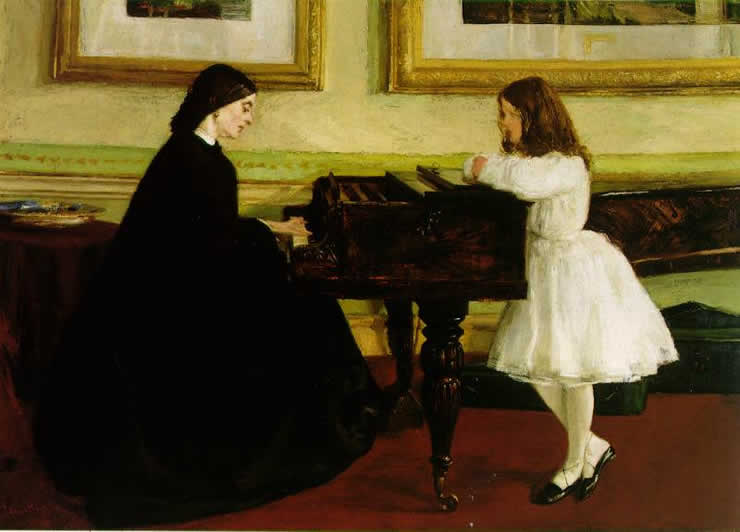
In 1860, Whistler submitted “At the Piano” again, this time to the Royal Academy exhibition. It was at this time that people finally began to take notice of the artist, not only for his great talent as a painter, but also for his flamboyant personality. He led a lavish lifestyle, despite being in debt often, and had a quick wit, and became friends with a number of other flamboyant personalities like Oscar Wilde.
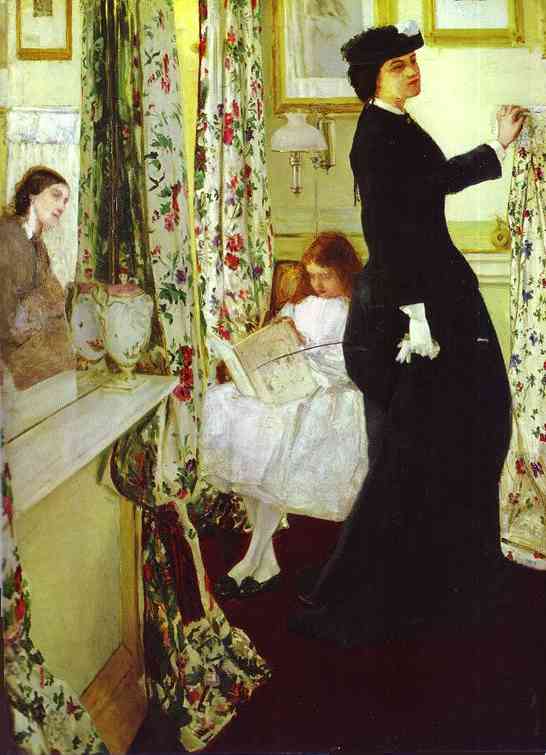
Despite living in London, Whistler would continue to travel to France quite often. Whistler’s work would again be rejected by both the Salon in Paris and the Royal Academy in London, most notably his controversial painting “The White Girl.” Whistler claimed that this painting supported his theory that art should not be about portraying the natural world, but about creating a beautiful arrangement of colors in harmony. This painting would later go on to be a great success at the Salon des Refuses in 1863.

In 1866, Whistler traveled to South America and painted a number of seascapes in Chile.
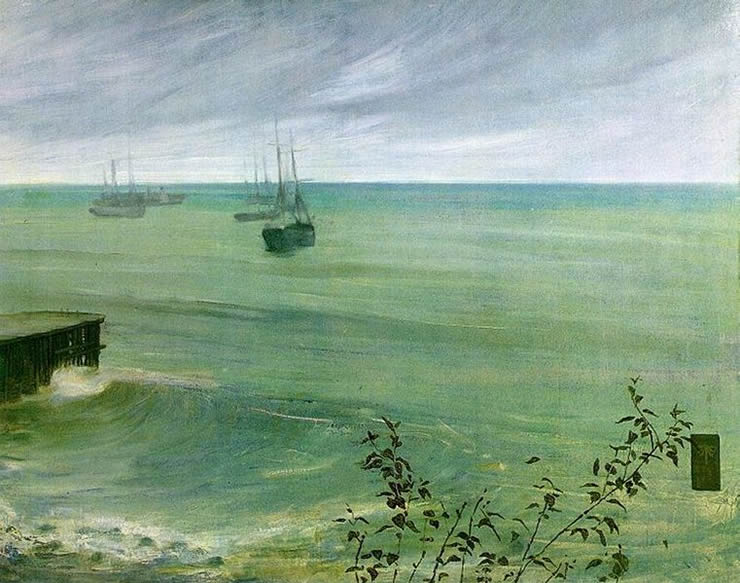
This would later lead to a series of landscapes which were called his “Nocturne” series, which showed different views of the Thames River.

Whistler was very passionate about his art, and his personality often seeped through into his paintings. Though today one may view his work as being rather subtle, the ideas that they were founded on were quite radical for his time. Whistler believed that a painting should not exist to convey a message, but for its own sake. Whistler insisted on calling his paintings “harmonies” or “arrangements” because he believed that his paintings should be free of hidden meanings and should just exist as something that appealed to the artistic eye. This, however, was not a popular idea and Whistler found himself again being denounced over his 1875 painting “Nocturne in Black and Gold: The Falling Rocket.”
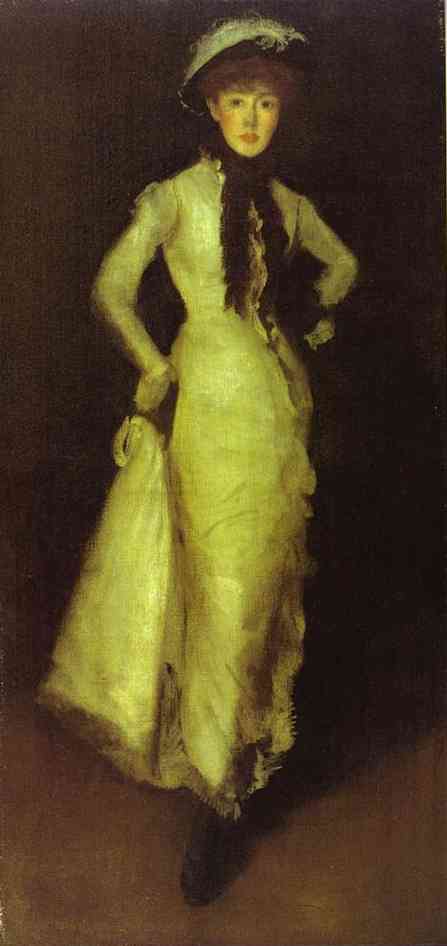
John Ruskin, an art critic likened the painting to “flinging a pot of paint in the public’s face.” Whistler promptly sued Ruskin for libel and won. However, Whistler only won a farthing and essentially helped to prove Ruskin’s point. The lawsuit sent Whistler into bankruptcy, and he was forced to sell his house and move to Italy in 1879. Fortunately, he received a commission to create etchings in Venice where he remained until 1880.
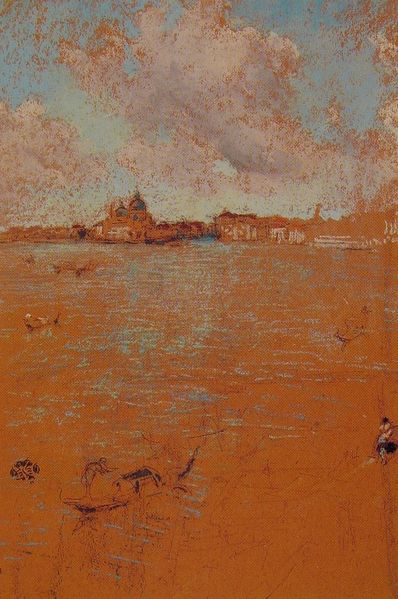
In 1880 Whistler returned to England where he continued to paint his symphonies as well as portraits. He was elected the president of the Society of British Artists in 1886, only to be voted out of office two years later. He was also awarded the Legion of Honor and was elected the president of the International Society of Sculptors, Painters and Gravers in 1898.

Throughout his life, Whistler produced a wide variety of oil paintings as well as dry points, etchings and lithographs. It is said that he created probably only half as many lithographs as etchings, and was a very gifted illustrator and etcher.




Whistler led a very interesting life full of drama and traveled the world. He was said to have mentored a man who was the rumored Jack the Ripper, and was also once falsely pronounced dead by a newspaper after a heart attack. Whistler truly left his mark on the art world and in history, and today we are left with an extensive oeuvre to remember him by. Today, Whistler’s work is housed worldwide in both the United States and Europe, and perhaps in your own home. Still wondering about an etching or oil painting hanging on your wall? Contact us… we are the James McNeill Whistler experts.
Reviews
1,217 global ratings
5 Star
4 Star
3 Star
2 Star
1 Star
Your evaluation is very important to us. Thank you.
